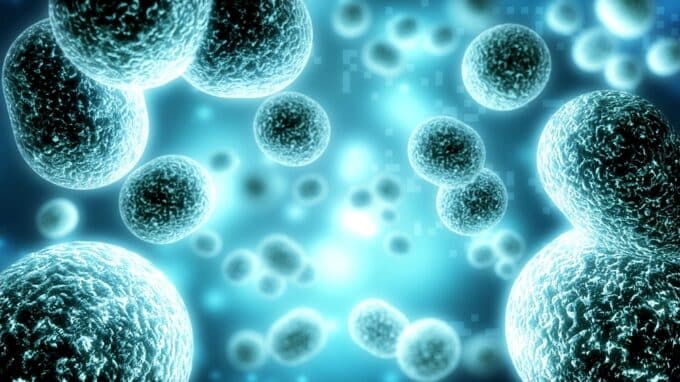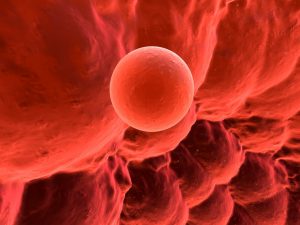The accumulation of misfolded or damaged proteins in long-lived, non-dividing cells such as neurons is associated with neurodegenerative diseases such as Alzheimer’s disease. A study now shows that the accumulation of these toxic proteins also affects egg quality and female fertility. The researchers discovered that mouse oocytes have specialized structures that move around in the cytoplasm and act like a clean-up crew that catches and holds on to protein aggregates to render them harmless. If it is not possible to break down the toxic proteins, defective oocytes develop. 3 out of 5 (60%) of the mouse embryos that had inherited the toxic proteins failed in the very first stages of development. The study opens up new possibilities for research into the mechanisms underlying poor egg quality, which is the main cause of female infertility.
How Oocytes Remain Intact for Decades
Oocytes are immature egg cells that develop before birth in almost all female mammals. The reproduction of future generations depends on this finite cell reserve surviving undamaged for many years. In mice this can be a period of up to eighteen months, while in humans it can last for almost half a century – the average time between birth and menopause. How cells achieve this remarkable feat of longevity has long been a burning question.
Researchers at the Center for Genomic Regulation (CRG) in Barcelona have discovered a new mechanism that explains how egg cells remain intact for decades without undergoing the deterioration that would lead to failure in other cell types. The results, published in the journal “Cell”, open up new possibilities for research into unexplained causes of infertility. The researchers investigated protein aggregates, i.e. clumps of incorrectly folded or damaged proteins. Uncontrolled, these harmful substances accumulate in the cytoplasm and have highly toxic effects. Protein aggregates are known to accumulate in nerve cells, and their effects have been linked to several neurodegenerative diseases. Cells usually cope with aggregates by breaking them down with special enzymes. They can also divide into two new cells, concentrating the aggregates in one of the cells and sparing the other.
But egg cells are not like other cells. Due to their long lifespan, they cannot break down toxic substances through cell division. The constant degradation of protein aggregates is an unsuitable strategy as it requires a high energy input that may not be available. Oocytes also have the task of donating their entire cytoplasm to an embryo after fusion with a sperm and therefore prefer to reduce their metabolic activity, a strategy that avoids the generation of by-products that can damage maternal DNA and impair future reproductive success. This makes the oocytes particularly sensitive to the effects of misfolded or damaged proteins. The researchers wanted to investigate how egg cells deal with these misfolded or damaged proteins.
Oocytes Use Unique Strategy to Get Rid of Harmful Protein Aggregates
Dr. Böke’s team, led by Dr. Gabriele Zaffagnini, first collected thousands of immature oocytes, mature eggs and early embryos from adult mice. Using special dyes, they observed the behavior of the protein aggregates in real time using a technique known as live cell imaging. They also used electron microscopy to take a closer look at nanoscopic details inside the cells – work that took five and a half years to complete.
The researchers discovered special structures in the egg cells, which they called EndoLysosomal Vesicular Assemblies – ELVAs for short. These structures – there are around 50 per egg cell – move around in the cytoplasm, where they capture and hold protein aggregates in order to render them harmless. Cells have many subcellular structures called organelles that perform similar functions to an organ in the body. Researchers refer to ELVAs as “superorganelles” because they are a network of many different types of cellular components that work together as a single unit.
The study revealed a crucial moment during the oocyte maturation phase, namely when an oocyte turns into a mature egg, preparing for ovulation and possible fertilization. At this stage, the researchers observed ELVAs moving to the cell surface and degrading the protein aggregates, essentially cleaning the cytoplasm thoroughly. This is the first observation of the unique strategy that oocytes use to get rid of protein aggregates.
An oocyte must donate all of its cytoplasm to the embryo at fertilization, so it cannot afford to accumulate junk that would pose an existential risk to its function. In this sense, ELVAs are like an elaborate waste disposal network or clean-up crew. They monitor the cytoplasm to ensure that no aggregates are floating free. ELVAs keep these aggregates in a confined environment until the oocyte is ready to dispose of them in one fell swoop.
Protein Aggregates Impair Egg Quality and Reduce Female Fertility
Fertility declines with age and poor egg quality is the main cause of female infertility. Infertility rates are also rising worldwide, with delayed motherhood being one of the contributing factors. Understanding how oocytes stay healthy and why these strategies fail with age is crucial to understanding unexplained causes of infertility and opening up new treatment options.
The results of the study suggest that the presence of protein aggregates could affect the quality of both the egg and the embryo. When the researchers experimentally prevented the ability of ELVAs to degrade protein aggregates during the egg maturation process, this led to the formation of defective oocytes. When the researchers intervened and “forced” the embryos to inherit aggregated proteins, 3 out of 5 (60%) failed to complete very early stages of development.
This research opens up an intriguing future direction to investigate whether protein degradation and problems with its regulation in oocytes could explain the age-related decline in embryonic health. Another type of long-lived cells that do not divide but still have to cope with protein aggregates are neurons. The accumulation of harmful substances in these cells is associated with the development of various types of neurodegenerative diseases, including Alzheimer’s disease. The study opens the door for future research beyond the field of reproduction.





